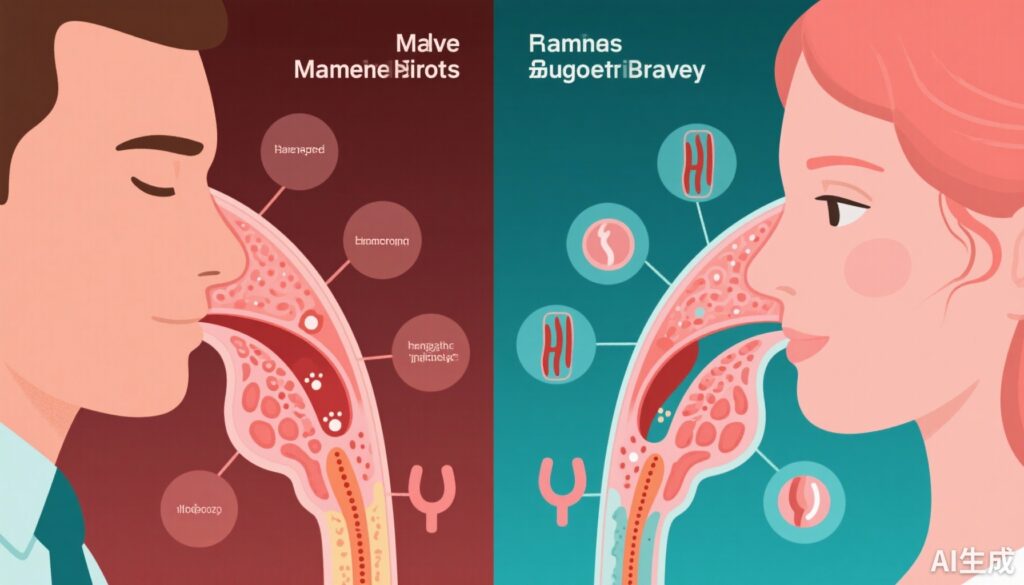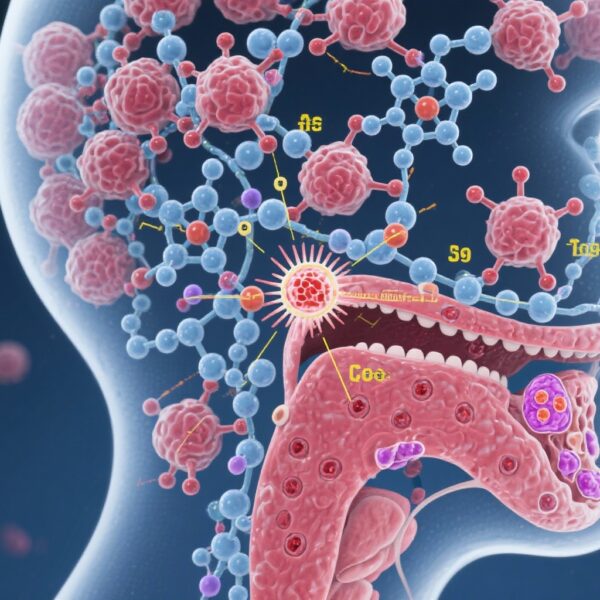Introduction
Chronic Rhinosinusitis (CRS) is a prevalent inflammatory condition affecting the nasal passages and paranasal sinuses, with significant clinical and economic burden worldwide. Despite its common occurrence, understanding the heterogeneity of CRS, especially regarding gender-based differences, remains limited. The disease manifests mainly as CRS with nasal polyps (CRSwNP) and CRS without nasal polyps (CRSsNP), each with distinct pathophysiological and inflammatory profiles.
Recent research highlights the influence of sex hormones on immune responses, which could modulate manifestations of CRS. Estrogen and testosterone are known to exert inflammation-modulating effects, suggesting that biological sex may be a critical factor in disease presentation, diagnosis, and biomarker profiles. However, comprehensive studies directly analyzing these differences in large populations are sparse.
This article reviews findings from a large cross-sectional study utilizing the All of Us Research Program dataset to elucidate sex-related differences in CRS diagnosis and associated biomarkers. Understanding these variations holds promise for advancing personalized medicine approaches in CRS management.
Study Background and Significance
CRS is characterized by persistent inflammation of the sinonasal mucosa, often leading to symptoms such as nasal congestion, facial pressure, and reduced quality of life. The condition’s underlying immunological mechanisms differ, with some patients exhibiting eosinophilic, type 2 inflammation, while others demonstrate alternative inflammatory pathways.
Given the documented influence of sex hormones on immune modulation, unravelling sex-specific differences could explain variations in disease prevalence, presentation, and response to treatments. Epidemiological data suggest that CRS with nasal polyps is more common in men, whereas CRS without polyps appears more prevalent in women, especially premenopausally. The potential biological basis of these disparities underscores the importance of investigating sex differences at the molecular level.
Study Design and Population
This cross-sectional study analyzed data from 258,245 adult participants collected between May 2018 and October 2023 from the All of Us Research Program, a comprehensive nationwide dataset. Participants were recruited from diverse healthcare settings, including academic centers, VA facilities, and community clinics. Individuals with incomplete data were excluded.
The primary exposures examined were biological sex (male or female), alongside covariates like age, demographics, socioeconomic status, risk factors, and comorbidities. The main outcomes investigated included CRS diagnosis—stratified into CRSwNP and CRSsNP—based on electronic health records, as well as CRS-related serum biomarkers.
presents significant findings, controlled for potential confounders, providing insights into sex-based differences in disease prevalence and immune profiles.
Main Findings and Results
The analysis revealed notable sex differences in CRS classifications:
- Female sex was associated with a higher odds of CRSsNP in both younger (<60 years) and older (≥60 years) age groups. Specifically, the odds ratios were 1.44 (95% CI, 1.35-1.54) and 1.32 (95% CI, 1.23-1.40), respectively.
- Conversely, females exhibited a lower likelihood of CRSwNP (OR, 0.63; 95% CI, 0.52-0.76) compared to males across age groups.
- Biomarker analysis indicated that females with CRSsNP had significantly lower serum eosinophil counts (β, -0.35; 95% CI, -0.44 to -0.25) and IgE levels (β, -99.73; 95% CI, -190.49 to -8.96). Similar trends were observed in patients with CRSwNP, with females showing lower eosinophil counts (β, -0.41; 95% CI, -0.80 to -0.01).
- Age-stratified analyses showed a downward trend in CRS prevalence among females aged 60 years or older, contrasting with an upward trend in younger females, suggesting hormonal influences related to aging could impact disease manifestation.
Regression analyses confirmed a significant interaction between female sex and age 60 years or older, associated with decreased odds of CRSsNP (OR, 0.91; 95% CI, 0.84-0.99).
Expert Commentary
These findings underscore the importance of considering biological sex in CRS diagnosis and management. The lower serum eosinophils and IgE levels in females suggest a potential female predilection for nontype 2 inflammation, aligning with the observed lower prevalence of CRSwNP among women. This could reflect differences in hormone-driven immune responses, with estrogen’s anti-inflammatory effects possibly reducing eosinophilic inflammation.
However, the cross-sectional nature limits causal inferences. Longitudinal studies are required to delineate how hormonal changes, especially in women approaching or post-menopause, influence CRS pathophysiology. Additionally, the study’s reliance on EHR data poses potential misclassification biases but offers a large, representative sample.
Recognizing sex-specific biomarkers could facilitate personalized approaches, possibly optimizing therapeutic strategies tailored to inflammatory endotypes and biological sex. Future research should integrate hormonal profiling and explore therapeutic implications, such as hormone modulation or targeted biologicals.
Conclusions and Future Directions
This extensive analysis emphasizes distinct patterns between male and female patients concerning CRS diagnosis and inflammatory biomarkers. Female sex appears to predispose to CRSsNP with less eosinophilic inflammation, particularly in aging women. These insights pave the way for sex-aware diagnostic and therapeutic strategies in CRS.
Further research should explore hormonal influences, longitudinal disease courses, and targeted treatments based on inflammatory endotypes and patient sex. Implementing these findings could enhance personalized medicine, improve patient outcomes, and address current gaps in CRS management.
Funding and ClinicalTrials.gov
No specific funding sources are reported. The study utilizes publicly available data from the All of Us Research Program.
References
1. Chiu RG, Ahn A, Eldeirawi K, et al. Biological sex and chronic rhinosinusitis diagnosis and biomarkers. JAMA Otolaryngol Head Neck Surg. 2025;10.1001/jamaoto.2025.3734.
2. Lanier A, Zhu J, Schleimer R. Sex Differences in Chronic Rhinosinusitis with Nasal Polyps. Curr Opin Otolaryngol Head Neck Surg. 2021;29(2):103-108.
3. Kim Y, Lee S, Lee H. The Role of Estrogen in Allergic Rhinitis and Sinusitis. J Allergy Clin Immunol. 2019;144(4):979-987.



